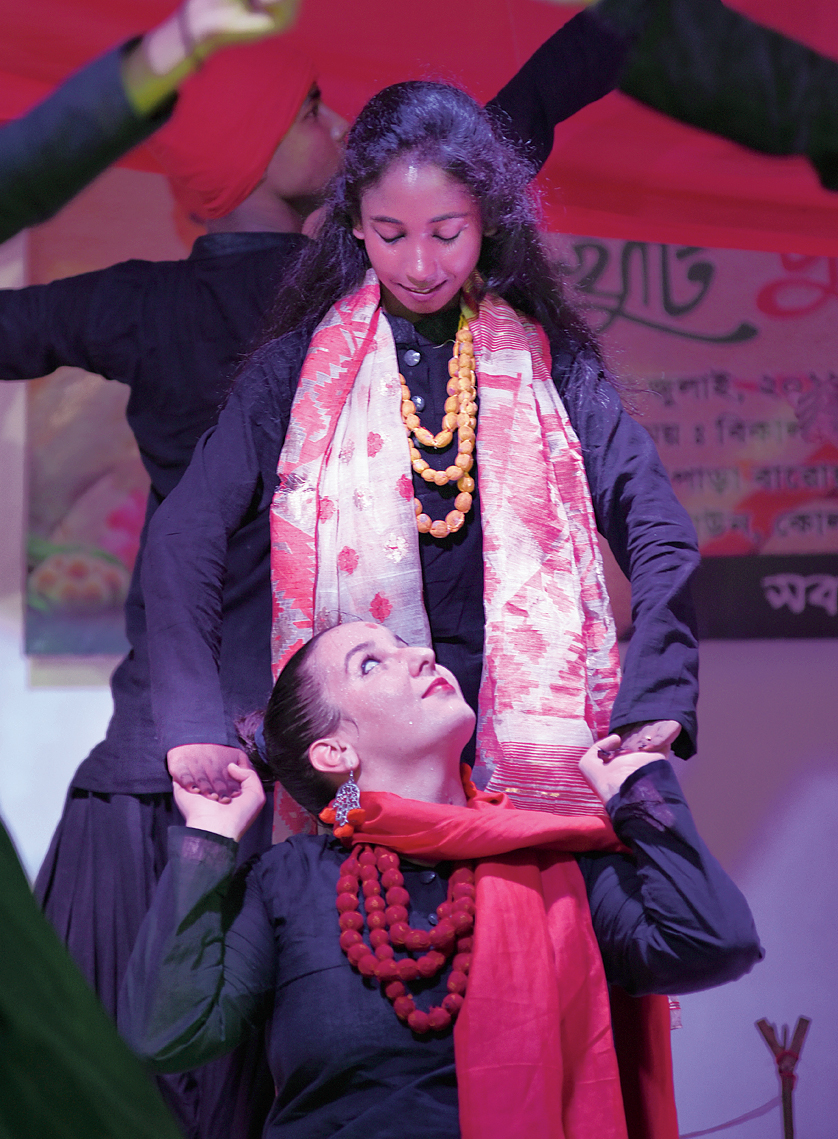Me? Touched by Ravana? How dare you assume that I wasn’t loyal to you this whole time? If you really think Ravana touched me then why’d you fight this war?
— Sita in Ramkahan
The khuti puja celebration of Aatghara Nawpara Baroari puja in Rajarhat featured a novelty this year — a musical featuring two American dancers in the cast. Malcolm Jefferson and Camille Schmitt were playing the roles of Ram and Sita in a production titled Ramkahan staged by the Salt Lake CG Block-based NGO Prayasam. The rest of the cast featured youths from the colonies of the neighbourhood where Prayasam works for community development.
The 45-minute show was unique in another respect. “We are telling the story of Ramayana from the perspective of Mandodari, Ravana’s queen,” said Amlan Ganguly, the founder of Prayasam, who wrote the script and choreographed the moves of the three groups of dancers involved in the production — Rama’s army, Ravana’s army and Mandodari’s female companions.
Several re-tellings of Ramayana were consulted, other than the epic itself, like Devdutt Pattanaik’s works, said Mili Roy, director, communication, at Prayasam, who helped Ganguly with the research. “The script was based on five decisions of Sita — leaving for the forest with Rama, crossing the Lakshmanrekha to give alms to Ravana, refusing to escape Lanka with Hanuman and insisting that Rama come and take her back, going for the trial by fire to prove her chastity and finally refusing to return to Ayodhya with Rama and opting to enter the Earth instead. Mandodari supports Sita all through her stay in Lanka despite dreaming of her husband’s eventual death,” Roy said.
The main characters — Rama, Sita, Ravana and Mandodari — were choreographed by Rashidi of Destiny Arts Center in Oakland, California, who had flown over with two of his students for the collaborative project.
“I couldn’t start the choreography till I got here. Rama has to have power and confidence. I have worked with Malcolm since he was eight and have seen him grow as a dancer. So he was a natural choice to play Rama. A lot of his movements are freestyle,” said Rashidi.
Malcolm, an alumnus of Destiny, was taken aback on learning that he had to “play a god”. “I visited some temples, besides reading the script, which gave me some insights. But then I am used to playing characters in dance,” said the 21-year-old towering African American.
Ganguly was hard put to find a Ravana in his camp to match up to Malcolm’s Rama. “I have never danced much in public. But when Dada asked me to put on weight some months before the show I realised he was considering me for Ravana,” said Manish Chowdhury, a Nazrul Pally boy, who runs the NGO’s community news channel.

Priya Sutradhar as Mandodari with Camille as Sita in Ramkahan

Manish Chowdhury as Ravana
So when Rashidi came, he asked Manish what he was capable of. “I showed him the kalaripayattu steps I had learnt in 2013, when I took part in my locality’s presentation at Prayasam’s annual day show.” That was all the experience he had. But the martial art form from Kerala satisfied Rashidi’s need. “He added a bit of hip hop to those in the two weeks I trained with him.”
The white and buxom Sita cut a contrasting figure to the caramel-skinned, wiry Mandodari. Priya Sutradhar of Dakshindari had never heard of Ravan’s wife but picked up her steps in seven days flat.
Camille, who had visited Prayasam last year as well with Rashidi, had heard an outline of The Ramayana story then. “But till I had a script I could not sink into it. Amlan made me understand the character through movements.”
She could deeply identify with Sita. “This production opens space for women to reflect on their decisions in life, whether they are doing things for themselves or losing the power over their lives. Because Sita wins, all women win,” said Camille, adding that Sita’s story would resonate with women all over the world in the time of the #MeToo movement when women are speaking up to reclaim their power and refusing to be put down by men.
The staging of the production was a success with people from the neighbourhood and beyond flocked to the venue behind City Centre 2.
The narrative in English was interspersed with appropriate songs from Hindi films. While Sita yearns for Rama in Lanka, Tujhe yaad kar liya hai from Bajirao Mastani plays in the background. As Rama enters Lanka and the battle is all set to break out, a tense Mandodari sings Samay o dheere chalo from Rudaali.
“We hardly ever stop to think that there is so much persecution of women in our mythological tales. Even the fusion dance was a novelty for us,” said secretary of the puja committee Debabrata Das.
The production will be staged next in California on November 2 for which Manish, Priya and Ganguly will fly over in end-October. In the US production, the rest of the caste will be played by American students.











